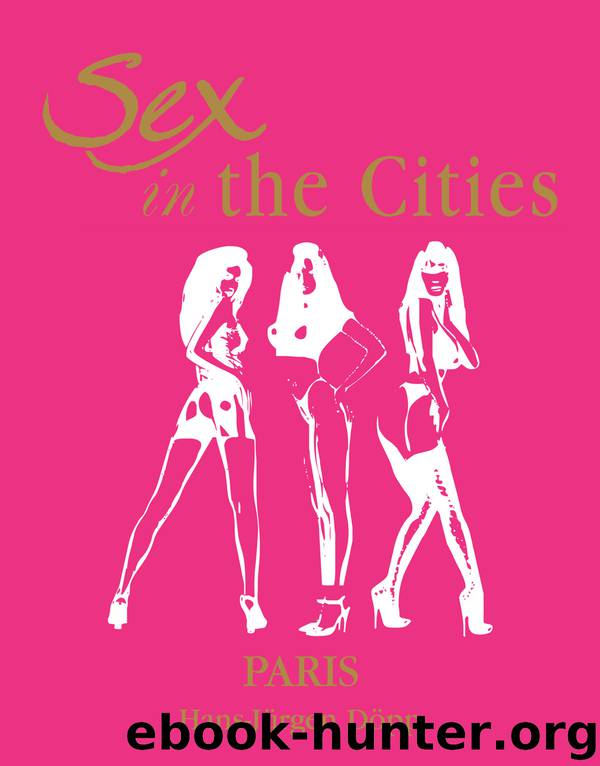Sex in the Cities Vol 3 (Paris) by HansJürgen Döpp

Author:HansJürgen Döpp [Döpp, Hans-Jürgen]
Language: eng
Format: epub
ISBN: 9781785259197
Publisher: Parkstone International
Melle Ernest, rue Rameau, No. 7,
et Melle Amélie, même maison, c. 1830.
From Adresse des prostituées. Coloured lithograph.
Une maison à partie, passage d’Artois, No. 10 (dans la boutique), c. 1830.
From Adresse des prostituées. Coloured lithograph.
It was in the carnival of the cholera-year, 1832 – of all times – that, in Paris, the dance appeared whose unmistakable obscenity immediately unleashed a great scandal – the cancan. It was primarily the Jeunesse dorée, who, looking for an antidote to the boredom which spread everywhere under the juste milieu, helped the cancan achieve success. “The cancan was offensive because it exposed and made public those passions which had previously been stifled by conventions – the kind of conventions that had found adequate expression in those round-dances, whose rigid elegance bored people silly by 1830. By flouting decency and morals, the cancan embodied permanent revolution, the rebellion of body and senses against an anti-physical morality.” This dance was a volcanic event which filled every respectable bourgeois with panic and terror. Deflated, people spoke of the cancan “with its dancing mania that partly caricatured the sexual process and partly exploited it in elaborate fantasy”. In reality, the obscenity was merely a means of pouring scorn on the hollowness and gloom of the bourgeois world. “The cancan, whose provocative power decreased in accordance with the way it became a popular folk-dance, was originally meant to be a travesty of those values to which the juste milieu clung and which it venerated. Their hollowness and mendacity were scornfully exposed by the rebellious Jeunesse dorée.” It was a mocking dance against bourgeois rules, values and regulations.
One indication of the increase in physical lust under the juste milieu is the mounting number of prostitutes in Paris after 1830. From police lists, Parent-Duchatelet reproduces figures which rose constantly between 1812 and 1829, though they reached their zenith from 1830 to 1832. The revolutionary period not only took over all of the “achievements” of gallant Rococo in the area of brothel-running, but also even structured it with greater refinement.
Under the Directoire, the number of brothels continued to increase. From 1830 until 1840, the total number of these “temples d’amour” increased further. Combined with an intensification of the venality of all things, democratisation of society led to an increase in prostitution. With the epoch of large-scale capital-accumulation there also began a period of outrageous expenditure of huge capital sums in the service of prostitution. But alongside the courtesans who lived in the lap of luxury, the “filles libres” accounted for most prostitutes. Ivan Bloch characterises the type of women concerned who, as some of our lithographs show, pursued prostitution under the guise of following a trade. Among these were the “grisettes”. They were mainly cleaning women, but were also serving-girls, flower-girls, sellers of fancy goods, sellers of lottery tickets, the singers in cafés chantants and women harpists. As early as the 18th century, under the general description of “grisette”, one understood the young girl to be “without birth or wealth”. In other words, she was someone from the working-classes who “.
Download
This site does not store any files on its server. We only index and link to content provided by other sites. Please contact the content providers to delete copyright contents if any and email us, we'll remove relevant links or contents immediately.
The Secret History by Donna Tartt(18161)
Red Sparrow by Jason Matthews(5195)
Harry Potter 02 & The Chamber Of Secrets (Illustrated) by J.K. Rowling(3556)
In a Sunburned Country by Bill Bryson(3367)
Drawing Cutting Edge Anatomy by Christopher Hart(3290)
Figure Drawing for Artists by Steve Huston(3270)
The Daily Stoic by Holiday Ryan & Hanselman Stephen(3110)
Harry Potter and the Prisoner of Azkaban (Book 3) by J. K. Rowling(3109)
Japanese Design by Patricia J. Graham(3000)
The Roots of Romanticism (Second Edition) by Berlin Isaiah Hardy Henry Gray John(2819)
Make Comics Like the Pros by Greg Pak(2758)
Stacked Decks by The Rotenberg Collection(2685)
Harry Potter and the Deathly Hallows (7) by J.K. Rowling(2550)
Draw-A-Saurus by James Silvani(2503)
Tattoo Art by Doralba Picerno(2486)
On Photography by Susan Sontag(2482)
Foreign Devils on the Silk Road: The Search for the Lost Treasures of Central Asia by Peter Hopkirk(2388)
Churchill by Paul Johnson(2364)
The Daily Stoic by Ryan Holiday & Stephen Hanselman(2344)
